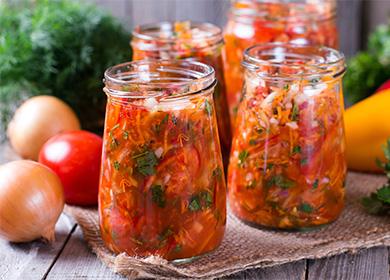It is recommended to close vegetables in jars of three liters. In such a container, large-sized fruits will fit. In order to fit as many diverse components as possible into a smaller container, small fruits are used. For example, instead of regular tomatoes, take cherry or cream. Components can be cut into pieces no thinner than a centimeter.
Conservation Rules
Preserving assorted vegetables for the winter is a simple matter, which even a novice can do. Strong vegetables are selected, without flaws and rot. Marinade is prepared from pure water, salt and a preservative - vinegar or lemon. Spices are to taste. The taste and “longevity” of the workpiece depend on seasonings. The table shows the options for the ingredients for pickling.
Table - The main composition of the conservation
| What to put | Ingredients and their quality |
|---|---|
| Vegetables | - clean; - intact; - young; - small and medium; - mature |
| Seasonings | - Green leaves of oak, currant, cherry, horseradish; - mint; - Bay leaf; - parsley; - dill; - cloves; - nutmeg; - garlic; - chili; - coriander grains; - mustard seeds |
| Salt | - Marine; - not iodized coarse grinding |
| Vinegar solution | - 5%; - 9% |
Assorted vegetables for the winter: 10 options
Assorted recipes for the winter are prepared according to the same algorithm. First sterilize containers and lids. You can do this in the microwave or in the oven. In order not to bother with sterilization for a long time, it is recommended to scald each container with boiling water before laying the ingredients. Then vegetables are prepared - washed, dried, peeled, cut. The ingredients are layered in containers: spices, large pieces, small fruits. For beauty, you can alternate vegetables by color. At the very end, a brine flows in.
Before spinning, some housewives sterilize filled cans, for example, in a large pan. You can not do this if an acetic solution or other preservative is present in the workpiece. Spicy spices prevent mold and fermentation. If only salt without acid is included in the brine, it is best to sterilize the container before closing.
"Garden"
Description. The simplest recipe for mixed vegetables in jars for the winter is the harvest “Garden”, because ingredients grow in almost any garden plot. If desired, instead of chilli, add segments of bell pepper.
What is needed:
- tomatoes - four pieces;
- cucumbers - four pieces;
- carrots - three pieces;
- onion - three pieces;
- white cabbage - 500 g;
- chili pod;
- head of garlic;
- a bunch of greenery;
- water - 1.2 l;
- salt - a tablespoon;
- 9% vinegar solution - a tablespoon.
How to cook
- Rinse all vegetables, dry.
- Chop the cabbage in strips or cut into small slices.
- Cut large tomatoes into quarters, chop the small fruits at the peduncle with a toothpick.
- Cut the peeled carrots into circles a centimeter thick.
- Chop the onion with thick rings.
- Boil the water and dip in boiled water for a couple of minutes in turn all the prepared ingredients.
- Put a slotted spoon on a napkin or clean towel.
- Place garlic, chili, spices, herbs, leaves at the bottom of the sterile container.
- Put dried vegetables on top.
- Add the remaining liquid and boil.
- Pour into containers, add vinegar.
- Roll up, turn over and leave to cool.
No sterilization
Description. The easiest cooking without sterilization is cold salting. It is enough to use filtered water, clean ingredients and containers. When stored in the refrigerator, such a blank will calmly “survive” until the winter. Cooking takes no more than an hour.
What is needed:
- dense small tomatoes - six pieces;
- small cucumbers - six pieces;
- sweet pepper - four pieces;
- head of garlic;
- cold water - 1 l;
- a bunch of dill;
- horseradish leaves - two pieces;
- currant or cherry leaves - two pieces;
- sugar - a tablespoon;
- salt - three tablespoons;
- vinegar solution - a tablespoon;
- spice.
How to cook
- Rinse and dry the vegetables thoroughly.
- Pierce the tomatoes at the stalk.
- Cut off the ends of the cucumbers.
- Slice the pepper into small slices.
- Put green leaves on the bottom, half of the garlic head.
- Tightly pack the ingredients.
- Pour the spices on top, put the remaining garlic.
- Pour in salt, sugar.
- Pour in water and vinegar.
- Roll up, put in the refrigerator.
Beets and Beans
Description. Prepared in a three-liter jar. String beans can be excluded. Fans of savory cuisine can add a chili pod.
What is needed:
- carrots - four pieces;
- white cabbage - 500 g;
- young zucchini - 300 g;
- bell pepper - two pieces;
- large onion;
- medium beets - two pieces;
- beans - eight pods;
- garlic - four teeth;
- laurel - two leaves;
- horseradish leaf;
- spice;
- water - 1 l;
- salt - a teaspoon;
- sugar - a tablespoon;
- 9% vinegar solution - a tablespoon.
How to cook
- Wash and dry the prepared ingredients.
- Peel the thick-skinned fruit.
- Slice the beet root vegetables and cabbage.
- Cut the remaining vegetables into rings.
- Put spices and leaves in a sterile container.
- Install the prepared components.
- Boil water, add sugar, salt.
- When the grains dissolve, pour in the vinegar solution and remove from the stove.
- Pour into a container, cover the neck with a lid.
- Sterilize for several minutes in a convenient way.
- Roll up, turn over and leave to cool.
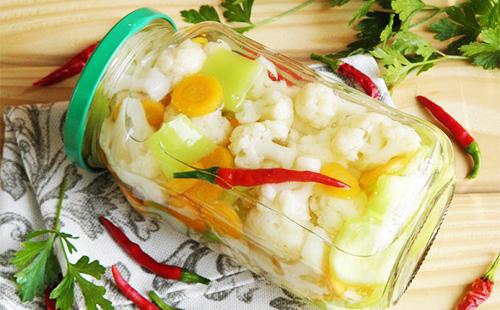
Instant crispy
Description. A crispy version of assorted vegetables with cabbage for the winter is prepared in a few minutes. Instead of white cabbage, cauliflower inflorescences are used.
What is needed:
- small cucumbers - nine pieces;
- cherry - five;
- carrots - two pieces;
- cauliflower - 200 g;
- garlic - three teeth;
- dill umbrella;
- laurel - three leaves;
- cloves - four buds;
- black pepper - three peas;
- water - 600 ml;
- salt - a tablespoon;
- sugar - a tablespoon;
- 9% vinegar solution - a tablespoon.
How to cook
- Rinse and dry the ingredients.
- Disassemble the cabbage for inflorescences.
- Cut peeled carrots into rings.
- Prick the cherry on the stalk with a toothpick.
- Put spices, laurel, dill umbrella, garlic cloves in a sterile jar.
- Lay the vegetables firmly in layers.
- Pour in salt, sugar.
- Boil water and pour into a container.
- Add vinegar solution.
- Roll up the jar, turn over, leave to cool.
Eggplant, apples, tomato paste
Description. Tasty, spicy platter can be served as a pickled salad with meat or fish. The amount of ingredients may vary according to taste preferences. Instead of zucchini, you can use pumpkin.
What is needed:
- zucchini - two pieces;
- eggplant - three pieces;
- tomatoes - 1.5 kg;
- a small carrot - five pieces;
- apples - 500 g;
- garlic - five cloves;
- water - 250 ml;
- sugar - three tablespoons;
- vinegar solution - two tablespoons;
- tomato paste - three tablespoons;
- laurel - three leaves;
- cloves - five buds;
- vegetable oil;
- spice.
How to cook
- Rinse all the ingredients, dry.
- Cut out apples from the core, peel the garlic.
- Pass the tomatoes, apple and garlic slices through a meat grinder.
- Put in a pan.
- Cut the skin from the carrots and cut into circles about a centimeter thick.
- Fry with a little oil.
- Put in a pan, add tomato paste, sugar, salt.
- Pour in water, mix.
- Boil for 35 minutes over low heat.
- Add a little oil, spices, vinegar.
- Dilute the thick mixture with boiling water and boil for another 15 minutes.
- Cut zucchini and eggplant in circles of two centimeters.
- Fry in oil and put in sterile jars.
- Pour the resulting sauce and roll up.
- Store after cooling in a cool place.
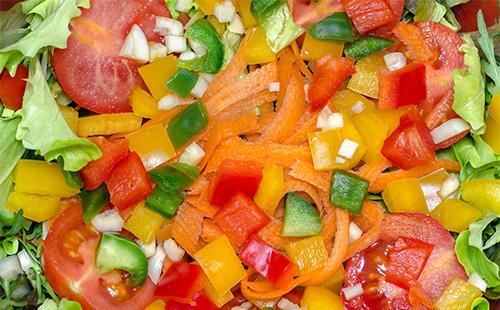
With corn
Description. For spinning, boiled ears are used. The water remaining from cooking does not drain, but is used in cooking. It is important that all storage containers are sterile, as corncobs often provoke bloated caps.
What is needed:
- boiled corn - two ears of corn;
- dense tomatoes - three pieces;
- cucumber;
- carrot;
- cauliflower - several inflorescences;
- corn broth - 500 ml;
- sugar - a tablespoon;
- salt - a teaspoon;
- apple vinegar solution - a tablespoon;
- currant - two leaves;
- cherry - three leaves;
- spice.
How to cook
- Put currants and cherries on the bottom of the sterile jar.
- Cut the ear into several pieces about two centimeters thick.
- Peel the carrots, cut into cubes.
- Disassemble the cabbage for inflorescences.
- Cut the cucumbers into several pieces.
- Use small tomatoes whole, previously pricking the stalk.
- Put all prepared vegetables on the leaves.
- Sprinkle spices on top.
- Add salt and sugar to the corn broth.
- Cook for several minutes until the grains are completely dissolved.
- When the mixture boils, turn off the stove, pour in the vinegar solution and pour into a jar.
- Cover and sterilize in any convenient way.
- Spin, flip and leave to cool.
Fast without preservation
Description. Assorted vegetables without long preservation for the winter. You can enjoy pickled vegetables after 12 hours. For convenience, the ingredients are salted in a jar with a screw cap.
What is needed:
- broccoli - two stumps;
- carrot;
- zucchini;
- cucumber - three pieces;
- sweet pepper - two pieces;
- bulb;
- garlic - four cloves;
- water - 500 ml;
- 5% vinegar solution - four tablespoons;
- salt - two teaspoons;
- soy sauce - four tablespoons;
- mustard seeds - two teaspoons;
- dry basil - a teaspoon;
- laurel - two pieces.
How to cook
- Wash the ingredients, peel the carrots, garlic, onions.
- Put garlic cloves, spices, bay leaves on the bottom of the sterile container.
- Cut all the vegetables into circles.
- Lay in layers in a jar.
- Pour in the sauce, vinegar, pour salt.
- Boil water and pour into a container.
- Cover the jar and put to sterilize.
- Screw on the lid, turn over and leave to cool.
Barrel pickled
Description. A pickled assortment of vegetables for the winter is more useful than rolled under an airtight cover.Traditionally fermented vegetables in a barrel, but modern chefs can use an enamel pan. Acetic solution is not added to the workpiece. The amount of ingredients is calculated according to the volume of the container. Vegetables and fruits are taken to taste.
What is needed:
- watermelon;
- cucumbers
- bell pepper;
- squash;
- cauliflower;
- apples
- carrot;
- plums
- celery;
- parsley;
- garlic;
- water;
- salt - 30 g per liter of water;
- spice.
How to cook
- Wash all the ingredients thoroughly, dousing with boiling water, discard the damaged and damaged fruits.
- Rub the inside of the barrel with garlic or put the cloves on the bottom of the pan.
- Cut large fruits and vegetables into slices, chop the small fruits.
- Put in dense layers in a container.
- Lay greens on top, pour spices.
- Dissolve salt in pure water and pour into a container, completely covering the ingredients.
- Install the press on top and leave at room temperature.
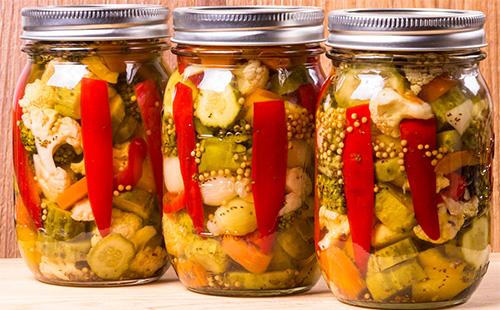
Vegetable jelly
Description. To prepare an unusual pickled assortment of vegetables for the winter, gelatin is used. The brine does not turn completely into jelly, but becomes thick. The advantage of the workpiece is that even soft components retain their elasticity and do not “spill over”. Often tomatoes are sliced in this way.
What is needed:
- small tomatoes - six pieces;
- cucumbers - four pieces;
- large onion;
- bell pepper - five pieces;
- garlic - four teeth;
- water - 600 ml;
- salt - a tablespoon;
- sugar - two tablespoons;
- horseradish leaf;
- a bunch of parsley;
- gelatin - 15 g;
- vinegar essence - a teaspoon;
- spice.
How to cook
- Soak gelatin according to instructions.
- Wash all ingredients, dry.
- Cut the ends of the cucumbers, chop the greens.
- Cut large fruits into rings and slices.
- Put leaves, spices, garlic on the bottom of a sterile jar.
- Pouring herbs, lay the ingredients in layers to fill the container completely.
- Boil water, pour sugar and salt.
- Add the swollen gelatin, mix.
- Pour the vegetables with the resulting hot brine.
- Pour the essence into the jar.
- Cork and let cool.
Lemon
Description. With intolerance to the vinegar solution, you can use a lemon, it is suitable for preservation and gives the ingredients a sour taste. A variety of vegetables can be added to the harvest if desired - cauliflower, carrots, broccoli, zucchini.
What is needed:
- cucumbers - 500 g;
- tomatoes - 500 g;
- water - 1.5 l;
- garlic - four cloves;
- a bunch of dill;
- citric acid - three teaspoons;
- salt - 30 g;
- sugar - 150 g;
- laurel - two leaves;
- cloves - three buds;
- spice.
How to cook
- Soak the washed cucumbers for two hours.
- Rinse and cut off the tails.
- Wash the tomatoes thoroughly and prick the stalk.
- Put the leaves, sprigs of dill, garlic cloves, cloves, spices to taste on the bottom of the sterile jar.
- Place cucumbers and tomatoes in a container.
- Boil water and pour into the container.
- Leave for five minutes under the lid.
- Drain, boil, pour back into the jar and return to the pan after a few minutes.
- Add sugar, salt, acid.
- Boil, fill the container to the very neck.
- Roll up the container, turn it over and leave to cool.
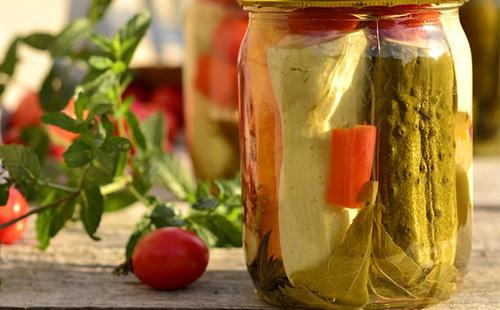
Is it possible to add aspirin
Some housewives add aspirin to the blanks. Acetylsalicylic acid creates an acidic environment in which microorganisms die, and vegetables remain crispy and elastic. In the process of heat treatment, the medicine breaks down into salicylic (phenolic) and acetic acid. If there is vinegar, it makes no sense to carry out a chemical reaction, the result will be the same.
The medicine in the marinade does more harm than good. Phenolic acid is an active substance used as an antipyretic and antimicrobial agent. Acid in large doses is toxic. The permitted dose is 2 g per 1 kg of weight. The constant use of blanks with medicine has a bad effect on the liver and kidneys.With prolonged use of phenolic acid, the body becomes immune to the drug. It is especially not recommended to use "aspirin" preparations for expectant mothers and children.
It is easy to prepare a vegetable assortment for the winter according to your individual taste. Choose your favorite vegetables, combine spicy and aromatic spices, add more salt or sugar. Regardless of the components and method of preparation, it is recommended to use the blanks in one winter.
Other homemade recipes
Apple cider vinegar at home
Fresh apple compote
Apple jam
Apple jam for the winter
